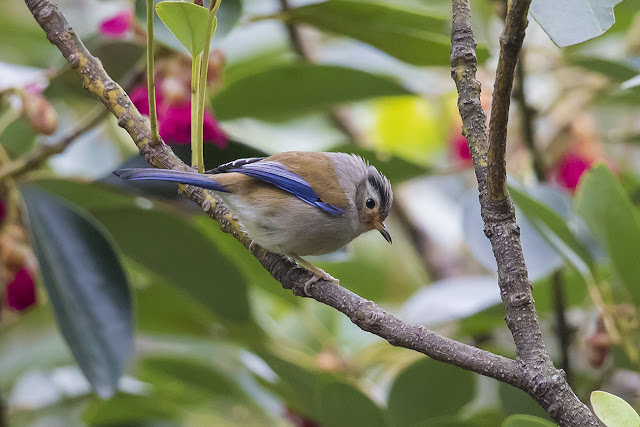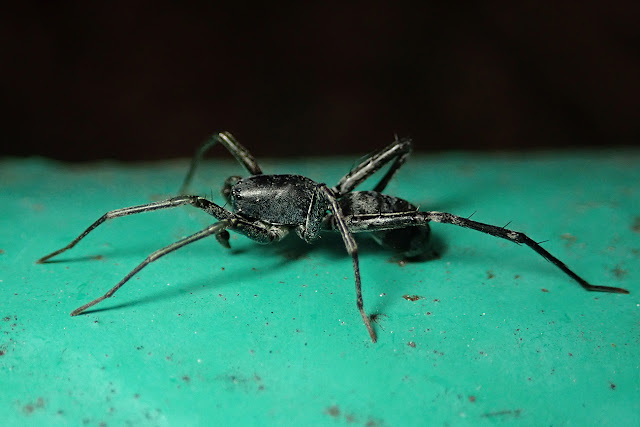The first 'twitchable' bird of the year came in form of a Fire-capped Tit seen at Kadorie Farm and Botanical Garden. News came from the Hong Kong Bird Watching Society forum, where a photo was uploaded to the 'Bird Identification' section, it was later confirmed to be a female Fire-capped Tit. I've seen this species before in Sichuan Emeishan, but this species had never been recorded in Guangdong, let alone Hong Kong! According to Richard Lewthwaite, the closest record for this species is one trapped in West Guangxi in 2013. This species is known for their seasonal migration from high to lower altitude during winter, where birds breeding at the foothills of the Himalayas can migrate all the way to North-Central India and northern Thailand. Therefore, for vagrants to turn up in Hong Kong is not impossible. Also, a dull looking female or juvenile is less likely to be a target of bird trade. Whether this bird gets accepted remains to be seen...If it does it will be a 1st for Hong Kong!
Fire-capped Tit : First Mega Rarity in 2019
Kenneth and I decided to go for the bird after another group of birders relocated it on a plum blossom tree along the main road of Kadorie Farm on the 28th. We met up and arrived at the gate at 9am to find a long queue of hikers and birders. There is a shuttle bus service that goes all the way to the top of the hill, but seats are limited, therefore people try to get there early to get a seat. We were obviously not early enough...So, we took the option to walk 20 minutes uphill. We were joined by James Kwok, Eric and Dephne Wong on our ascend. All the birders were standing around when we arrived, a clear sign that the target had yet to arrive. We waited for 10 minutes and all of a sudden a small bird appeared in the plum tree, pecking at the flower buds, the sound of camera shutters filled the valley...
'Twitchers' in Action
Fire-capped Tit - feeding in the blossoming plum tree
The Fire-capped Tit showed exceptionally well for the next hour or so, feeding constantly. This bird was just as how I remembered it from Sichuan, being quite bold and active. It was seemingly oblivious to the huge crowed congregating below the tree. This species was previously assigned to the family of Penduline Tits, but it's nesting habit in tree holes was most untypical, therefore it is now placed in with the Tits, but under a monotypic genus of Cephalopyrus.
Fire-capped Tit
While we waited around for the Fire-capped Tit, a few birds of prey drifted past, including a pair of very vocal Crested Serpent Eagles. I was hoping for an Oriental Honey Buzzard but only yielded an Eastern Buzzard.
Crested Serpent Eagle
Eastern Buzzard
The blossoming plum and cherry trees also attracted hundreds of Redbase Jezebels, they are probably one of the commonest butterflies in Hong Kong, but it's still a wonderful sight to see so many.
Redbase Jezebel
After we've had satisfactory views of the Fire-capped Tit, we ventured up to the T.S Woo Memorial Pavilion to look for a recently reported Mrs. Gould's Sunbird that's been feeding in the blossoming cherry trees. We were greeted by a lot of Japanese White-eyes also enjoying the abundance of nectar.
Cherry Blossoms
Japanese White-eye - active and everywhere!
It wasn't long until the rather scruffy looking immature male came into view, light was very harsh and and terrible for photography, but it was still nice to catch up with this rare winter visitor. The bird only showed briefly and never returned for another look.
Mrs. Gould's Sunbird - immature male
Elsewhere this January, many expected species had returned to known locations, including a few Common Rosefinches returning to Shek Kong Airfield, I managed to get a few record shot of this rather shy male feeding in the thick vegetation. Chinese Grosbeaks are however much more friendly and gave eye-level views.
Common Rosefinch - male
Chinese Grosbeak - female
A Rook had been reported at Lut Chau yet again, I finally took the time to have a look at it and confirmed it to be a different bird to the one I saw at Long Valley, this was a juvenile while the bird I found was an adult. This is the 3rd bird in two years, really quite incredible when you think that we only had our first ever one last year.
Rook and Collared Crow
At Wa Shan Tsuen in Sheung Shui, some birders had found a rather tamed Red-breasted Flycatcher and a male Grey Bush Chat. The flycatcher was very obliging, not surprising as it was receiving a generous amount of meal worms offered by the photographers. The Grey Bush Chat was however minding it's own business, foraging in the nearby fields. Two female Daurian Redstarts were also present, quite often chasing away the Red-breasted Flycatcher.
Red-breasted Flycatcher
Grey Bush Chat - male
Daurian Redstart - female
Finally, Kenneth and I were putting in the effort of finding a photographable Bright-capped Cisticola near Ma Tso Lung, the Cisticolas were not very cooperative, only showed briefly from afar, but this male Plaintive Cuckoo was more than happy to show, allowing a fairly decent shot.
Plaintive Cuckoo - male
It's really warming up, I heard the first Koel calling just the other day, spring seems to be just around the corner now.



















































